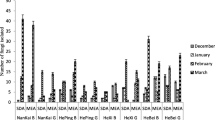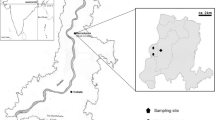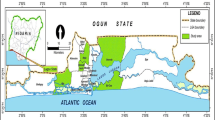Abstract
Microbial species such as bacteria and fungi can be transported by dust storms over long distances, and may change the mycobiota in downwind. This study aimed to evaluate phenotypes and genotypes of airborne fungi during the Middle Eastern dust (MED) events and normal days in Khorramabad, Iran. The samples were collected regularly every six days at three locations during April 2018–March 2019, with additional samplings during MED days. For phenotypic analyses, the Petri dishes were incubated at 25 °C for 72–120 h. Molecular identification of fungi was carried out using polymerase chain reaction (PCR). The average (±SD) of total fungal concentration was 460.9 (±493.2) CFU/m3. The fungi with the highest average concentrations included Cladosporium cladosporioides, Penicillium brevicompactum, and Cladosporium iridis, respectively. The average concentration of fungi during dust days (967.65 CFU/m3) was 3.6 times higher than those in normal days (267.10 CFU/m3). During normal and dust days, 61 and 45 species were detected, respectively. Aspergillus and Cladosporium spp. were relatively more dominant during normal and dust days, respectively. Eight fungal species were only observed during MED days, including Talaromyces albobiverticillius that was detected for the first time in Iran. Despite air temperature, relative humidity and wind speed were associated to the fungal concentrations. Dust events lead to the changes in the air pollutants composition and mycobiota, identification of new fungi, and elevated fungal concentrations that may extremely affect the public health.



Similar content being viewed by others
References
Perez L, Tobías A, Querol X, Pey J, Alastuey A, Díaz J, Sunyer J. Saharan dust, particulate matter and cause-specific mortality: a case-crossover study in Barcelona (Spain). Environ Int. 2012;48:150–5. https://doi.org/10.1016/j.envint.2012.07.001.
Stafoggia M, Zauli-Sajani S, Pey J, Samoli E, Alessandrini E, Basagaña X, Cernigliaro A, Chiusolo M, Demaria M, Díaz J, Faustini A, Katsouyanni K, Kelessis AG, Linares C, Marchesi S, Medina S, Pandolfi P, Pérez N, Querol X, Randi G, Ranzi A, Tobias A, Forastiere F, MED-PARTICLES Study Group, et al. Desert dust outbreaks in southern Europe: contribution to daily PM(10) concentrations and short-term associations with mortality and hospital admissions. Environ Health Perspect. 2016;124(4):413–9. https://doi.org/10.1289/ehp.1409164.
Tobías A, Pérez L, Díaz J, Linares C, Pey J, Alastruey A, et al. Short-term effects of particulate matter on total mortality during Saharan dust outbreaks: a case-crossover analysis in Madrid (Spain). Sci Total Environ. 2011;412–413:386–9. https://doi.org/10.1016/j.scitotenv.2011.10.027.
Ashrafi K, Fallah R, Hadei M, Yarahmadi M, Shahsavani A. Source apportionment of total suspended particles (TSP) by positive matrix factorization (PMF) and chemical mass balance (CMB) modeling in Ahvaz, Iran. Arch Environ Contam Toxicol. 2018;75(2):278–94. https://doi.org/10.1007/s00244-017-0500-z.
Shahsavani A, Naddafi K, Jafarzade Haghighifard N, Mesdaghinia A, Yunesian M, Nabizadeh R, et al. The evaluation of PM10, PM2.5, and PM1 concentrations during the Middle Eastern Dust (MED) events in Ahvaz, Iran, from april through september 2010. J Arid Environ. 2012;77:72–83. https://doi.org/10.1016/j.jaridenv.2011.09.007.
Moghaddam VK, Changani F, Mohammadi A, Hadei M, Ashabi R, Majd LE, et al. Sustainable development of water resources based on wastewater reuse and upgrading of treatment plants: a review in the Middle East. Desalin Water Treat. 2017;65:463–73.
Chao HJ, Chan C-C, Rao CY, Lee C-T, Chuang Y-C, Chiu Y-H, Hsu HH, Wu YH. The effects of transported Asian dust on the composition and concentration of ambient fungi in Taiwan. Int J Biometeorol. 2012;56(2):211–9. https://doi.org/10.1007/s00484-011-0413-x.
Kianisadr M, Ghaderpoori M, Jafari A, Kamarehie B, Karami M. Zoning of air quality index (PM(10) and PM(2.5)) by Arc-GIS for Khorramabad city, Iran. Data Brief. 2018;19:1131–41. https://doi.org/10.1016/j.dib.2018.05.063.
Khaniabadi YO, Fanelli R, De Marco A, Daryanoosh SM, Kloog I, Hopke PK, et al. Hospital admissions in Iran for cardiovascular and respiratory diseases attributed to the Middle Eastern Dust storms. Environ Sci Pollut Res Int. 2017;24(20):16860–8. https://doi.org/10.1007/s11356-017-9298-5.
Hadei M, Nazari SSH, Yarahmadi M, Kermani M, Farhadi M, Shahsavani A. Estimation of gender-specific lung cancer deaths due to exposure to PM2.5 in 10 cities of Iran during 2013–2016: A modeling approach. Int J Cancer Manag. 2017;10(8):13–21. https://doi.org/10.5812/ijcm.10235.
Ebrahimi SJ, Ebrahimzadeh L, Eslami A, Bidarpoor F. Effects of dust storm events on emergency admissions for cardiovascular and respiratory diseases in Sanandaj. Iran J Environ Health Sci Eng. 2014;12:110. https://doi.org/10.1186/s40201-014-0110-x.
Nourmoradi H, Moradnejadi K, Moghadam FM, Khosravi B, Hemati L, Khoshniyat R, et al. The effect of dust storm on the microbial quality of ambient air in Sanandaj: a city located in the west of Iran. Global J Health Sci. 2015;7(7):114–9. https://doi.org/10.5539/gjhs.v7n7p114.
Honda A, Sawahara T, Hayashi T, Tsuji K, Fukushima W, Oishi M, et al. Biological factor related to Asian sand dust particles contributes to the exacerbation of asthma. J Appl Toxicol. 2017;37(5):583–90.
Tong DQ, Wang JXL, Gill TE, Lei H, Wang B. Intensified dust storm activity and Valley fever infection in the southwestern United States. Geophys Res Lett. 2017;44(9):4304–12. https://doi.org/10.1002/2017GL073524.
Soleimani Z, Goudarzi G, Naddafi K, Sadeghinejad B, Latifi SM, Parhizgari N, et al. Determination of culturable indoor airborne fungi during normal and dust event days in Ahvaz, Iran. Aerobiologia. 2013;29(2):279–90.
Soleimani Z, Goudarzi G, Sorooshian A, Marzouni MB, Maleki H. Impact of Middle Eastern dust storms on indoor and outdoor composition of bioaerosol. Atmos Environ. 2016;138:135–43.
Rippon J. Medical mycology: the pathogenic fungi the pathogenic actinomycetes. 3rd ed. Philadelphia, PA: WB Saunders; 1988.
Makimura K, Tamura Y, Mochizuki T, Hasegawa A, Tajiri Y, Hanazawa R, et al. Phylogenetic classification and species identification of dermatophyte strains based on DNA sequences of nuclear ribosomal internal transcribed spacer 1 regions. J Clin Microbiol. 1999;37(4):920–4.
Shinn EA, Griffin DW, Seba DB. Atmospheric transport of mold spores in clouds of desert dust. Arch Environ Health. 2003;58(8):498–504.
Jones AM, Harrison RM. The effects of meteorological factors on atmospheric bioaerosol concentrations—a review. Sci Total Environ. 2004;326(1):151–80. https://doi.org/10.1016/j.scitotenv.2003.11.021.
Ho H-M, Rao CY, Hsu H-H, Chiu Y-H, Liu C-M, Chao HJJAE. Characteristics and determinants of ambient fungal spores in Hualien. Taiwan. 2005;39(32):5839–50.
Burch M, Levetin E. Effects of meteorological conditions on spore plumes. Int J Biometeorol. 2002;46(3):107–17.
Frisvad JC, Yilmaz N, Thrane U, Rasmussen KB, Houbraken J, Samson RA. Talaromyces atroroseus, a new species efficiently producing industrially relevant red pigments. PLoS One. 2013;8(12):e84102.
Chen A, Sun B, Houbraken J, Frisvad JC, Yilmaz N, Zhou Y, et al. New Talaromyces species from indoor environments in China. Stud Mycol. 2016;84:119–44.
Griffin DW, Westphal DL, Gray MAJA. Airborne microorganisms in the African desert dust corridor over the mid-Atlantic ridge, Ocean Drilling Program, Leg 209. Aerobiologia. 2006;22(3):211–26.
Mincuzzi A, Sanzani S, Garganese F, Ligorio A, Ippolito AJ. First report of Talaromyces albobiverticillius causing postharvest fruit rot on pomegranate in Italy. J Plant Pathol. 2017;99(1):303.
Griffin DW, Kubilay N, Koçak M, Gray MA, Borden TC, Shinn EA. Airborne desert dust and aeromicrobiology over the Turkish Mediterranean coastline. Atmos Environ. 2007;41(19):4050–62.
Liu S-T, Liao C-Y, Kuo C-Y, Kuo H-W. The effects of PM(2.5) from Asian Dust storms on emergency room visits for cardiovascular and respiratory diseases. Int J Environ Res Public Health. 2017;14(4):428. https://doi.org/10.3390/ijerph14040428.
Jassim MS, Coskuner G. Assessment of spatial variations of particulate matter (PM 10 and PM 2.5) in Bahrain identified by air quality index (AQI). Arab J Geosci. 2017;10(1):19.
Yarahmadi M, Hadei M, Nazari SSH, Conti GO, Alipour MR, Ferrante M, et al. Mortality assessment attributed to long-term exposure to fine particles in ambient air of the megacity of Tehran, Iran. Environ Sci Pollut Res. 2018;25(14):14254–62.
Karagulian F, Temimi M, Ghebreyesus D, Weston M, Kondapalli NK, Valappil VK, Aldababesh A, Lyapustin A, Chaouch N, Hammadi F, Abdooli A. Analysis of a severe dust storm and its impact on air quality conditions using WRF-Chem modeling, satellite imagery, and ground observations. Air Qual Atmos Health. 2019;12(4):453–70. https://doi.org/10.1007/s11869-019-00674-z.
Namdari S, Karimi N, Sorooshian A, Mohammadi G, Sehatkashani S. Impacts of climate and synoptic fluctuations on dust storm activity over the Middle East. Atmos Environ. 2018;173:265–76. https://doi.org/10.1016/j.atmosenv.2017.11.016.
Mannaa M, Kim KD. Effect of temperature and relative humidity on growth of Aspergillus and Penicillium spp. and biocontrol activity of Pseudomonas protegens AS15 against Aflatoxigenic Aspergillus flavus in stored Rice grains. Mycobiology. 2018;46(3):287–95. https://doi.org/10.1080/12298093.2018.1505247.
Bamba I, Azuma M, Hamada N, Kubo H, Isoda N. Case study of airborne fungi according to air temperature and relative humidity in houses with semi-basements adjacent to a forested hillside. Biocontrol Sci. 2014;19(1):1–9.
Acknowledgments
The authors wish to thank Tehran University of Medical Sciences for their full support of this PhD thesis at Mycology (#thesis number: 38506-27-02-97, and ethical code: IR.TUMS.SPH.REC.1397.268).
This work was conducted as a Ph.D. student thesis of Mohammad Yarahmadi at Mycology. The authors wish to thank Tehran University of Medical Sciences (TUMS) for their full support of this study (Grant number: 97-02-27-38506, and ethical code: IR.TUMS.SPH.REC.1397.268).
Author information
Authors and Affiliations
Corresponding author
Ethics declarations
Conflict of interests
The authors declare that they have no conflict of interest.
Additional information
Publisher’s note
Springer Nature remains neutral with regard to jurisdictional claims in published maps and institutional affiliations.
Electronic supplementary material
ESM 1
(DOCX 576 kb)
Rights and permissions
About this article
Cite this article
Yarahmadi, M., Hashemi, S.J., Sepahvand, A. et al. Evaluation of phenotypes and genotypes of airborne Fungi during middle eastern dust storms. J Environ Health Sci Engineer 18, 11–20 (2020). https://doi.org/10.1007/s40201-019-00428-0
Received:
Accepted:
Published:
Issue Date:
DOI: https://doi.org/10.1007/s40201-019-00428-0




